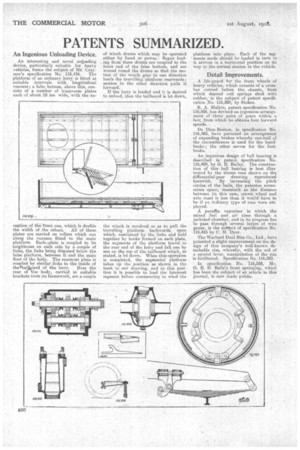PATENTS SUMMARIZED.
Page 22

If you've noticed an error in this article please click here to report it so we can fix it.
An Ingenious Unloading Device.
An interesting and novel .unloading device, particularly suitable foe heavy vehicles, forms the subject of Mi'..Cray
rrier's specification No. 116,416. The platform of an ordinary lorry is fitted at suitable intervals with ldngitudinal runners; a false bottom, above this, consists of a number of transverse plates each ci about 18 ins. wide,..with the 'ex
ception of the front one, which is dnublo
the width of the others. All of these plates are carried on rollers which run along the runners fitted to the main platform. Each plate is coupled to its neighbouss on each side by a couple of .links, the links being disposed below the false platform, between it and the Main floor of the body. The rearmost plate is coupled by similar links to the. inside of
theirtailkoard of the lorry. Near the rear of he body, carried in suitable brackets from its framework, are a couple of winch drums which may be operated either .by hand or power.., Ropes leading from these drums are coupled to the front end of the false bottom, and are wound round the drums so that the motion of the winch gear in one direction hauls the travelling platform rearwards; motion in the other direction pulls it forward.
If the lorry is loaded and it is desired to unload; then the tailboard is let down,
the winch is revolved so as to pull the travelling platform backwards, upon which, restrained by the links and held together by hooks formed on each plate, the segments of the platform travel to the rear end of the lorry and fall one by one on the top of the tailboard which, as stated, is let down. When this operation is completed, the segmental platform takes up the position as shown in the inset to our drawing, and in this position it is possible to load the foremost segment before commencing to wind the platform into place. Each of the segments made should be loaded in turn as it arrives in a horizontal position on its way to the normal station in the vehicle.
• Detail Improvements. . .
A' life-guard for the front wheels of heavy vehicles, which consi.sts of a crossbar carried before the c.hassis, from which depend coil springs shod with rubber' is the subject of patent specification No. 116,389, by Stokes.
B. A. Malkin, patent specification No. 116,456, has devised an ingenious arrangement ofthree pairs of gears within a box; from which he obtains four forward speeds. • .
Dion-Bcniton, in specification No. 116,483, have patented an arrangement of eXpanding brakes whereby one-half of the circumference is -used for the handbrake; the other serves for the footbrake.
. An ingenious design of hall bearing, is described in patent specification No. 116,489, by G. D. Bailey. The construction of this ,ball bearing is best -Milstrated by the thrust race shown on the differential gear drawing reproduced herewith. By increasing the pitchcircles; of the balls, the patentee economizes space, inasmuch as the 'distance betWeen (in this case, crown, wheel and axle case) is less than it would have to -be if en ordinary type of race were employed.
A paraffin vaporizer in which the mixed fuel and air rises. through a jacketed chamber, and in its progress has to pass through several layers of wire gauze, is the subject of specification No. 116,415 by C. M. Dyer.
The Warland Dual Rim Co., Ltd., have patented a slight improvement on the design of this company's well-known detachable rim, whereby, with the. aid of a special lever, manipulation of the rini is facilitated. Specification No. 116,383.
In specification No. 116,358, Mr. G. E. D. Ralls's front springing, which has been the subject of an article in this journal, is now made public.






















